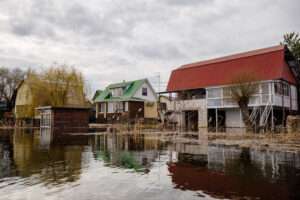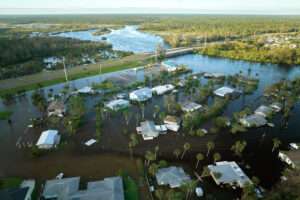Published August 9, 2024
By Lindsay Fenlock, Senior Researcher at the Center for International Environmental Law, and Charles Slidders, Senior Attorney, Financial Strategies at the Center for International Environmental Law, and Nikki Reisch, Director of the Climate & Energy Program at the Center for International Environmental Law. .
This is the third in a multi-part series, “Insuring the Climate Crisis,” which analyzes the intersection of the climate emergency and the insurance crisis.
On July 21, the world experienced the hottest global temperature on record, only to surpass that record the next day. However, not everyone experiences the impacts of this heat and other climate-exacerbated disasters equally. As summer intensifies, the impacts of climate change — especially extreme heat— are becoming more severe, disproportionately affecting low-income and minority populations.
In the US, a history of racial discrimination in finance and housing policies has left Black, Indigenous, and People of Color (BIPOC) communities more susceptible to the impacts of climate change and less equipped to recover from extreme weather disasters. Today, home insurers are pulling out of areas they perceive as risky to climate hazards, once again leaving BIPOC communities behind.

From Redlining to Bluelining
The disparate impact of climate change on property and infrastructure in US minority communities is the result of nearly a century of discriminatory home lending and insurance policies.
In the 1930s, the US federal government used a rating system in its low-cost home loan program to assess lending risk. Assessors created maps ranking the perceived risk of lending in certain neighborhoods, with race often used as the determining factor in assessing a community’s risk level. Black and immigrant neighborhoods were typically rated as ‘hazardous’ and outlined in red, warning lenders that the area was a perilous place to lend money. This practice became known as redlining, and the term is often used today to refer to racial discrimination in any government or corporate financial policies.
Redlining and other discriminatory practices, such as racial profiling in the provision of home insurance, led to a lack of investment in minority and vulnerable communities. This lack of financial access resulted in shoddy construction and poor infrastructure that has made minority neighborhoods less resilient to climate change.
Though redlining is now illegal, its legacy endures. These neighborhoods’ growing exposure to climate-related damage has left them vulnerable to other financial risks. Not only are homes in these areas more likely to be damaged by climate hazards, but insurers are more likely to increase insurance rates if they determine that properties are more likely to suffer environmental damage. This new financial practice is known as bluelining, and it occurs when insurers raise their prices or pull out of areas that they perceive to be at greater environmental risk.
While not illegal, bluelining disproportionately impacts minority and lower-income residents. Bluelining — the ‘new’ redlining — is now placing both the physical and financial burden of climate change on those least equipped to deal with its impacts.
How Past Redlining Created Climate Vulnerable Communities
In many US cities, maps from the 1930s showing redlined neighborhoods could be used as modern flood risk maps. A Redfin study reveals that $107 billion worth of homes in formerly redlined neighborhoods face high flood risks — 25 percent more than in non-redlined, predominantly white neighborhoods. Other studies have found that formerly redlined neighborhoods are more vulnerable to extreme heat and more likely to experience prolonged power outages during a storm. These disparities are a direct result of nearly a century of divestment and restricted access to capital, which deprived these neighborhoods of critical climate resilience infrastructure such as sewers and levees to capture flood waters and green spaces to absorb rising heat.
As a result of this lack of infrastructure, minority and vulnerable communities in the US face the most severe and direct effects of climate change. In a 2021 study, the US Environmental Protection Agency (EPA) confirmed that “racial and ethnic minority communities are particularly vulnerable to the greatest impacts of climate change.”
This vulnerability and racial disparities are evident when climate disasters strike. For example, when Hurricane Katrina struck New Orleans in 2005, four out of seven zip codes that faced the costliest flood damage were at least 75 percent Black. Similarly, Hurricane Harvey in 2017 hit historically black neighborhoods in Houston the hardest, and many residents there lacked a safety net to recover. Winter Storm Uri, in February 2021, brought persistent subfreezing temperatures to the southeastern US, resulting in electricity and water outages, substantial personal property damage, and increased mortality rates. The impact of the winter storm was likewise “disproportionately concentrated among low-income communities and communities of color.” Communities that are mostly Black, Latino, or Native American also experience 50 percent greater vulnerability to wildfires compared with other communities.
Despite these patterns, many cities have done little to bolster climate resilience in minority-dominated neighborhoods. For instance, Black communities from “Texas through Florida to Virginia” are projected to see at least a 20 percent increase in flood risk over the next thirty years.
This increased vulnerability not only exposes minority communities to damage from climate hazards, but also to bluelining from insurers. When a disaster strikes in a neighborhood, rates are likely to go up the following year. This affects both homeowners and renters, who often bear the costs of a landlord’s rising insurance costs.
Access to Insurance Is a Key Factor in Climate Change Resilience
Discrimination in the insurance sector extends beyond bluelining. Studies suggest that insurance claims following a disaster in areas with a higher Black population are less likely to be paid and, if they are paid, are likely to settle for less than other claims. A New York Times article supports these findings, presenting evidence of race discrimination in insurance company payout decisions for homeowners following disasters.
This racial discrimination, combined with bluelining, limits access to property insurance for vulnerable communities — a critical tool for climate resilience. Studies show that households with insurance are more likely to rebuild, face less financial hardship, and recover more quickly than households without insurance. As climate change exacerbates natural hazards like hurricanes and wildfires, widespread access to insurance will be necessary to help vulnerable communities survive.
The climate change-induced insurance crisis and bluelining — seriously undermine the ability of minority and vulnerable communities to access affordable insurance. Without insurance, minority communities are less able to adapt to climate change and less resilient when confronting these climate change-induced severe weather events. More importantly, minorities are hindered in their efforts to rebuild, particularly in rebuilding climate-resilient structures.
The compounded effects of the insurance crisis, rooted in past discriminatory insurance practices, perpetuate systemic inequities. The cycle of divestment from redlining to bluelining will increase systemic inequities and embed the disproportionate impact of climate change on minority and vulnerable communities for generations.
A Call to Action
Insurers should financially support and actively engage in community efforts addressing climate risk, community impact, and creating equitable solutions. Simultaneously, insurers must end their hypocritical and unconscionable conduct of investing large portions of their increasing premium income in fossil fuel companies, the undisputed drivers of climate change, and underwriting new oil and gas projects while turning away homeowners in high-risk climate zones. Public funding or support from local, state, or national government for the insurance industry must be contingent on the industry reducing investments and insurance commitments in carbon emissions causing climate change.
